Value Line Investment Research
Value Line Investment Research
Access in-depth financial information, research, commentary, and analysis for stocks.
View the how-to user guide
No comments
Access in-depth financial information, research, commentary, and analysis for stocks.
View the how-to user guide
No commentsFree or discounted passes to local museum and cultural institutions. Learn more about how to use this service by reading this PDF document.
No commentsLearn more about any subject, whether you are a child, teen, or adult.
View a 3-minute introductory video
No commentsLearn a new language. Choose from 71 languages, including Spanish, French, Arabic, Japanese, and English.
View a 6-minute introductory video
View an e-Brochure on how to get started
Ver un folleto electronic sobre como empezar
No comments¡Déjame oírte decir C-a-b-a-l-l-o ! Vamos a aplaudirlo.
Cómo las palabras se pueden juntar para comunicar ideas e información conduce a la comprensión; hablar con los niños es especialmente bueno para ayudarlos a pensar. Asegúrese de que su hijo pueda hablar con usted, no solo escucharlo hablar. Responda a lo que dice su hijo y siga su ejemplo. Responda las preguntas de su hijo de la manera más completa posible. Sus explicaciones ayudan a su hijo a aprender más sobre el mundo.
Si su hijo no está hablando, hágale preguntas, espere a que reaccione con un gesto o balbuceando, y luego hágale comentarios, como “Sí, los dos conejitos se están persiguiendo”. Pídale a su niño que le cuente algo que le haya sucedido hoy; Pida más detalles para que su hijo pueda ampliar la historia. Haga preguntas con más de un “sí” o un “no” como respuesta. Esto anima a su hijo a pensar en posibles soluciones ya hacer más preguntas. Aumenta las habilidades de comprensión.
Usa palabras nuevas. Los buenos lectores tienen un amplio vocabulario. Saber muchas palabras ayuda a los niños a comprender mejor lo que leen. Comience temprano, incluso antes de que sus hijos aprendan a hablar. Turnarse. Los niños están empezando a aprender a tener una conversación. Necesita hacer preguntas y escuchar las respuestas de sus hijos. Haz conexiones. Ayude a los niños a recordar eventos pasados y conéctelos con actividades actuales y futuras. Ayuda a los niños a comprender que el lenguaje puede representar eventos que no están sucediendo ahora.
Únete a nuestro programa de lectura de verano abierto a todas las edades. ¡Únete!
¿Conoces nuestro Dial-A-Story? Llame y escuche una historia mientras viaja, espera o camina. Historias disponibles en inglés y español. 530-298-9990.
Libros recomendados:
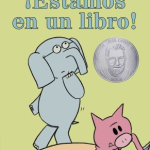 ¡Estamos en un libro! por Mo Willems
¡Estamos en un libro! por Mo Willems
Esta entrada fue escrita por la especialista en Alfabetización Familiar de la Biblioteca del Condado de Yolo, Letty Flores. ¡Gracias, Lety!
No commentsLet me hear you say C-O-W! Let’s clap it.
How words can be put together to communicate ideas and information leads to comprehension; talking with children is especially good at helping them think. Ensure your child can speak with you, not just listen to you talk. Respond to what your child says and follow their lead. Answer your child’s questions as completely as possible. Your explanations help your child learn more about the world.
If your child isn’t talking, ask questions, wait for them to react with a gesture or by babbling, and then give feedback, such as, “Yes, the two bunnies are chasing each other.” Ask your toddler to tell you about something that happened to them today; ask for more details so your child can expand on the story. Ask questions with more than a “yes” or “no” answer. This encourages your child to think about possible solutions and to ask more questions. It increases comprehension skills.
Use new words. Good readers have a large vocabulary. Knowing lots of words helps children better understand what they read. Begin early, even before your children learn to talk. Take turns. Children are just beginning to learn how to have a conversation. You need to ask questions and listen to your children’s responses. Make connections. Help children remember past events and connect them to current and future activities. It helps children understand that language can represent events that are not happening now.
Join our summer reading program open to all ages. Sign up!
Do you know about our Dial-A-Story? Call and listen to a story while on the go, waiting, or walking. Stories are available in English and Spanish. 530-298-9990.
Recommended books:
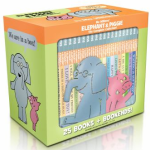
We are in a Book by Mo Willems
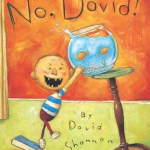
This blog entry was written by Yolo County Library’s Family Literacy specialist, Letty Flores. Thank you, Letty!
No commentsScribbling is FUN!
Reading and writing go together. Both are ways to represent spoken words and to communicate information or tell stories. Children become aware that printed letters stand for spoken words as they see print used in their daily lives. They see parents and others read newspapers, food labels, road signs, and mail. They watch caregivers write lists, jot down reminders, or make notes on a calendar.
Children develop a knowledge of the purpose and meaning of reading through writing.
Once your child can grasp a thick crayon or marker, give him or her unlined paper and plenty of opportunities to draw and write.
Talk to your child about what he or she draws, ask questions, and respond to what your child says. You also can make up a story to go with the drawing. As children scribble and draw, they practice eye-hand coordination and exercise the muscles in their fingers and hands. This helps develop the fine motor control they need to write letters and words.
Encourage your children to “sign” their name on their drawings. Even if this begins as a scribble, children learn that they can write something that represents their name. Later your child will write the initials of his or her first and last name and then the complete name.
Ask your child to label parts of his or her drawings. This also helps your child understand that letters and words stand for things.
Check out the Art bilingual backpack to explore scribbling, drawing and writing together!
Here are some books to enjoy:
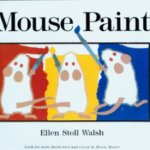 Mouse paint by Ellen Stoll Walsh
Mouse paint by Ellen Stoll Walsh
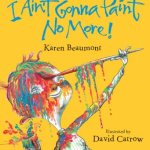
I ain’t gonna paint no more! by Karen Beaumont; illustrated by David Catrow
This blog entry was written by Yolo County Library’s Family Literacy specialist, Letty Flores. Thank you, Letty!
No commentsHacer garabatos es DIVERTIDO!
Leer y escribir van juntos. Ambas son formas de representar palabras habladas y de comunicar información o contar historias. Los niños se dan cuenta de que las letras impresas representan palabras habladas, ya que ven que las letras se usan en su vida diaria. Ven a los padres y otras personas leer los periódicos, las etiquetas de los alimentos, las señales de tráfico y el correo. Observan a los cuidadores escribir listas, anotar recordatorios o tomar notas en un calendario.
Los niños desarrollan un conocimiento del propósito y el significado de la lectura a través de la escritura.
Una vez que su hijo pueda agarrar un crayón grueso o un marcador, déle papel sin renglones y muchas oportunidades para dibujar y escribir.
Hable con su hijo sobre lo que dibuja, haga preguntas y responda a lo que dice. También puedes inventar una historia para acompañar el dibujo. A medida que los niños hacen garabatos y dibujan, practican la coordinación ojo-mano y ejercitan los músculos de los dedos y las manos. Esto ayuda a desarrollar el control motor fino que necesitan para escribir letras y palabras.
Anime a sus hijos a “firmar” su nombre en sus dibujos. Incluso si esto comienza como un garabato, los niños aprenden que pueden escribir algo que represente su nombre. Posteriormente su hijo escribirá las iniciales de su nombre y apellido y luego el nombre completo.
Pídale a su hijo que etiquete partes de sus dibujos. Esto también ayuda a su hijo a comprender que las letras y las palabras representan cosas.
¡Mira la mochila bilingüe de arte para explorar garabatear, dibujar y escribir juntos!
Aquí hay algunos libros sugeridos para que disfruten:
 Pinta ratones par Ellen Stoll Walsh ; traducción de Gerardo Cabello
Pinta ratones par Ellen Stoll Walsh ; traducción de Gerardo Cabello
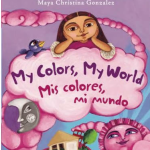 My colors, my world = Mis colores, mi mundo par Gonzalez, Maya Christina.
My colors, my world = Mis colores, mi mundo par Gonzalez, Maya Christina.
Esta entrada fue escrita por la especialista en Alfabetización Familiar de la Biblioteca del Condado de Yolo, Letty Flores. ¡Gracias, Lety!
No commentsAmidst a sea of gray clouds and freezing temperatures, early on the morning of January 16 the sun was not missed. Standing among hundreds of people armed with umbrellas, wrapped in brightly colored scarves, hats, and gloves united for a single cause, the warmth of the sun was felt in human form. The bubbling of voices grew and grew as more people arrived in the parking lot of Sacramento City College. Some with banners illustrated the iconic image of the day Martin Luther King Jr. gave his famous “I Have A Dream” speech. Others wore T-shirts with the words of the man and the reason we were all ready to march nearly 4 miles in his memory.
Amidst a hustle and bustle of presenters going up and down the stage and briefly presenting their speeches, I remember someone saying:
“They may cut all the flowers but they can’t stop the spring.”
As we marched, I could hear the lively laughter of the people around me amidst the blaring music. It was in those moments that I reflected on the rebellious nature of flowers and the inevitability of a vernal dream.
Martin Luther King Jr, the man who once dreamed of a future both free and equitable has not only passed that dream on to his people. But in his legacy, he has awakened a desire to watch, listen and learn among other peoples, like my own. So today, I invite you to do the same. Here are two great books about the life and dream of Martin Luther King.
March on! the day my brother Martin changed the world by Christine King Farris; illustrated by London Ladd
Martin Luther King Jr. by Dharathula H. Millender ; illustrated by Al Fiorentino
No commentsEntre un mar de nubes grises y temperaturas congelantes, temprano en la mañana del 16 de Enero el sol no hacía falta. Parada entre centenares de personas armadas con paraguas, bien arropadas en bufandas, gorras y guantes de colores brillantes unidas por una sola causa, se hacía sentir el calor del sol en forma humana. El burbujeo de voces crecía y crecía entre más gente llegaba al estacionamiento del Sacramento City College. Algunos con pancartas ilustraban la icónica imagen del día en el que Martin Luther King Jr. dio su famoso discurso “Tengo Un Sueño”. Otros portaban camisetas con las palabras del hombre y la razón por la cual estábamos todos listos para marchar casi 4 millas en su memoria.
Entre un ajetreo de presentadores subiendo y bajando la tarima y brevemente presentando sus discursos, recuerdo que alguien dijo:
“Podrán cortar todas las flores pero no podrán detener la primavera.”
Al marchar, podía oír las risas vivaz de la gente a mi alrededor entre la música a todo volumen. Fue en esos momentos que reflexioné sobre la rebelde naturaleza de las flores y la inevitabilidad de un sueño vernal.
Martin Luther King Jr, el hombre que un día soñó con un futuro tanto libre como equitativo para su gente no solo ha transmitido ese sueño a su pueblo. Si no que en su legado, ha despertado el deseo de observar, escuchar y aprender entre otros pueblos. Así que hoy les invito a hacer lo mismo y les comparto dos libros sobre la vida y el sueño de Martin Luther King.
Martin Luther King escrito por María Isabel Sánchez Vegara ; ilustrado por Mai Ly
Martin Luther King Jr. : una vida de determinación escrito por Sheila Rivera
No comments530-666-8005
Library Friends and Foundation
We acknowledge that we are on the traditional territory and homelands of the Yocha Dehe Wintun Nation. For more information, please go to: www.yochadehe.gov
.Strategic Priorities, 2022-2027
Mission, Vision, History, and County Librarian
Loan periods, Limits, and Fees